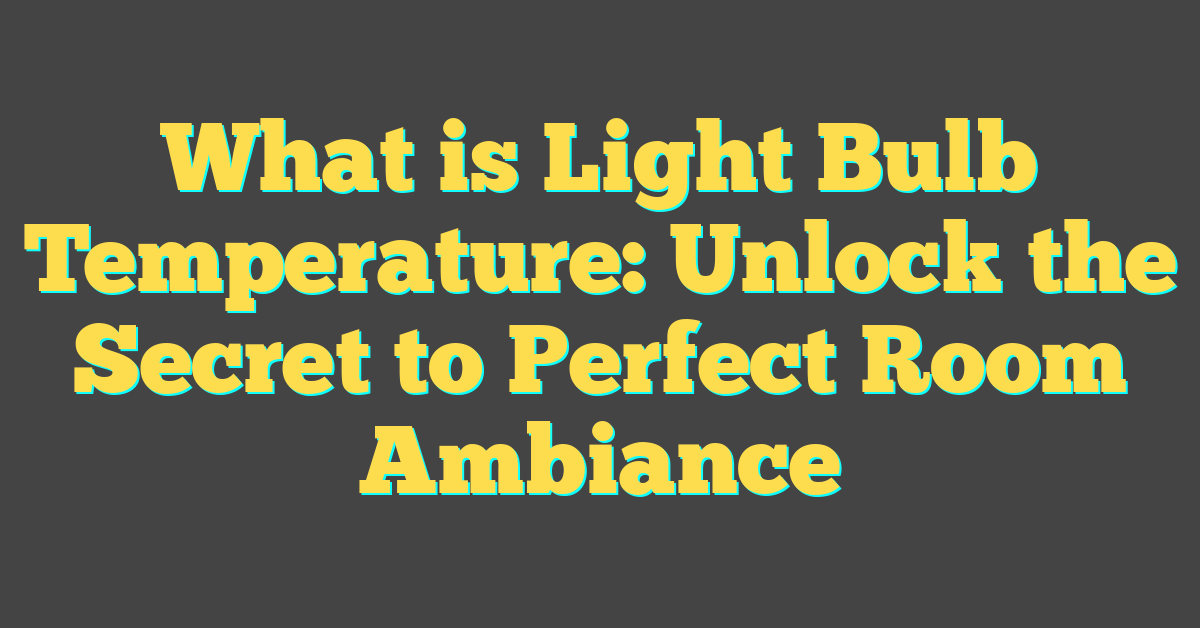Ever wandered through the lighting aisle and felt overwhelmed by the choices? You’re not alone! One key factor that often puzzles shoppers is light bulb temperature. It’s not about how hot the bulb gets; it’s about the color of the light it emits.

Understanding light bulb temperature can transform the ambiance of your space from cozy to clinical with just a switch. Let’s dive into what this term really means and how it affects your everyday lighting decisions.
What is Light Bulb Temperature?
You might find yourself pondering what exactly light bulb temperature is when browsing the lighting aisle. It’s not about the heat your bulb emits but rather the color of light it produces.
The technical term for this is correlated color temperature (CCT), measured in Kelvins (K). Simply put, lower Kelvin numbers mean the light appears more yellow and warm, reminiscent of a candlelight dinner. Alternatively, higher numbers indicate a cooler, blue-white hue, like daylight on a cloudless afternoon.
Understanding CCT is essential for setting the right mood. Here’s a quick guide to help you out:
- 2700K – 3000K: These temperatures are warm and inviting. Perfect for living rooms or bedrooms where you want a cozy, relaxed feel.
- 3100K – 4500K: This range is considered neutral or cool white. Great for kitchens and bathrooms where clarity and crisp lighting are appreciated.
- 4600K – 6500K: At this level, the light is very cool and starts to mimic daylight. It’s energizing and best suited for workspaces or garages where tasks require your keen attention.
As a DIY enthusiast and lighting aficionado, you’ll appreciate how different temperatures can transform a space. Let’s dive into how these temperatures apply to various types of bulbs.
Incandescents typically offer that warm, familiar glow, generally below 3000K. LEDs, on the other hand, are the chameleons of lighting. They span the entire temperature spectrum, allowing you to achieve whatever atmosphere you’re aiming for. CFLs tend to be on the cooler side, often used in utility spaces where the warmth of the light is less important.
Next time you tackle a home project, consider the bulb temperature that’ll complement your vision. Whether you’re refurbishing a vintage lamp or installing recessed lighting, your color temperature choice plays a pivotal role. It’s about creating ambiance, influencing mood, and enhancing the function of a room. After all, lighting is not just about seeing clearly—it’s about experiencing a space to its fullest.
The Color of Light

When diving deeper into the world of light bulb temperature, you’ll find yourself surrounded by a spectrum of colors that can influence every corner of your living space. Imagine holding a painter’s palette, but instead of paints, you’re armed with different shades of light. Correlated Color Temperature plays the role of your color chart, guiding you through warm oranges to cool blues.
Light color, measured in Kelvins, can encompass a wide range from the intimate glow of a candle to the crisp daylight at noon. The lower the Kelvin number, the warmer and more welcoming the light tends to be. Picture the golden hues of a sunset at 1,500 to 1,700K offering a cozy, relaxing feel to your room. On the opposite end, higher Kelvin numbers, like 5,000 to 6,500K, mimic the clear blue sky on a sunny day and can energize an environment.
Bulb types such as LEDs, CFLs, and the classic incandescents offer different temperature ranges. LEDs, for instance, boast a wide Kelvin range, allowing you the flexibility to tailor the atmosphere of your space with pinpoint accuracy. Here’s a quick rundown of what you might typically find:
| Bulb Type | Kelvin Range |
|---|---|
| Incandescent | 2,700K – 3,000K |
| CFL | 2,700K – 6,500K |
| LED | 2,500K – 6,500K |
Understanding the impact of light color on mood and ambiance is fundamental in DIY home projects. Whether you want to unwind in a soothing bath or need concentration for your home office, the color of your light bulbs can make all the difference. Play around with different temperatures to see which ones suit your activities and spaces best. Just remember, while you’re experimenting with bulb temperatures, pay attention to not only how the light looks but also how it makes you feel. After all, lighting should complement your life, not complicate it.
Different Light Bulb Temperature Options

Venturing into the array of light bulb temperatures, you’ll find that each bulb casting its hue can set the tone for any room. Understanding your options is key to making informed choices, whether you’re aiming for a soothing ambiance or a vibrant workspace.
Warm White to Soft Yellow (1,000K – 3,000K)
« What Are Light Bulbs Good For? Uncover Their Surprising Uses & Benefits
Do Light Bulbs Need to Be CSA Approved? Essential Safety Tips Revealed »
In the cozy corner of the temperature spectrum, warm white to soft yellow choices are ideal for lounges, bedrooms, and living areas – any space where relaxation is the goal. Here, you’ll generally encounter:
- Traditional incandescent bulbs
- Some halogens
- Warm LED options
Imagine the gentle glow of a sunset bathing your room in a welcoming light. That’s the warmth of a lower Kelvin bulb.
Bright White to Cool White (3,001K – 5,000K)
As the Kelvin scale climbs, so does the crispness of the light. In the range of bright white to cool white, you’re looking at a spectrum that’s perfectly suited for:
- Kitchens
- Bathrooms
- Home offices
The neutral tone strikes a comfortable balance between warm and cool, setting a fresh and alert atmosphere without tipping into harshness.
Daylight to Blue Sky (5,001K – 10,000K)
Feel as though you’re working under the clear blue sky with daylight to blue sky options. This end of the spectrum is most often utilized in:
- Design studios
- Artistic spaces
- Certain industrial settings
Daylight bulbs typically offer the highest color rendering index (CRI), meaning colors appear as vivid and true-to-life as under natural sunlight.
Here’s a quick reference table on the temperature scale for light bulbs:
| Kelvin Range | Color Description | Ideal Setting |
|---|---|---|
| 1,000K – 3,000K | Warm White to Soft Yellow | Relaxing spaces |
| 3,001K – 5,000K | Bright White to Cool White | Workspaces and kitchens |
| 5,001K – 10,000K | Daylight to Blue Sky | Creative and work areas |
Choosing the Right Light Bulb Temperature for Your Space

Selecting the perfect light bulb temperature can drastically alter the ambiance of your room. Imagine the warm, cozy glow of a fire; that’s the effect you want to capture with bulbs in the lower Kelvin range for spaces like living rooms and bedrooms. Conversely, spaces that demand clarity, like kitchens and home offices, benefit from higher Kelvin bulbs that mimic daylight.
Here’s how to match light bulb temperature to your space:
- Living Rooms and Bedrooms: Opt for bulbs in the 2700K to 3000K range to enhance comfort and relaxation.
- Kitchens and Bathrooms: A range of 3000K to 4000K is ideal as it provides a crisp environment without being too harsh.
- Home Offices and Studies: Aim for a cooler 4000K to 5000K to help keep you alert and focused.
Remember, layering light with a mix of fixtures can create a dynamic and flexible space. Dimmer switches are a fantastic investment, allowing you to adjust light bulb temperature according to your needs or the time of day.
Color perception is essential in areas like walk-in closets or art studios. Here, a color temperature that doesn’t distort colors is crucial. Natural daylight bulbs (5000K to 6500K) provide the trueness of color you need for tasks like matching your outfit or painting a canvas.
When it’s time to replace bulbs, consider the mood you’re hoping to generate. It’s not just about brightness; it’s about the shade of light and how it makes you feel. Overhead fixtures vs. accent lighting play significant roles in shaping the room’s overall temperature effect.
| Room Function | Preferred CCT Range |
|---|---|
| Living Rooms | 2700K to 3000K |
| Kitchens | 3000K to 4000K |
| Home Offices | 4000K to 5000K |
| Art Studios | 5000K to 6500K |
Don’t overlook the impact of light bulb temperature in outdoor areas. For front porches or backyard patios, a warmer color temperature can invite a sense of calm and coziness, perfect for evenings spent outside.
How Light Bulb Temperature Affects Mood and Ambience

Imagine the warm glow of a sunset bathing your living room in soft light. Now, picture the crisp, bright tone of a midday sky overhead in your home office. These scenarios illustrate the profound impact light bulb temperature can have on the mood and ambiance of a space. Whether you realize it or not, every time you switch on a light, you’re setting the stage for your room’s emotional tone and visual appeal.
Correlated color temperature (CCT) plays a pivotal role in interior design and your overall well-being. For instance, bulbs with lower Kelvin values yield a warmer, more inviting light often associated with relaxation and comfort. They’re excellent in creating a cozy atmosphere in bedrooms and living areas where you unwind after a busy day.
On the flip side, higher Kelvin bulbs emit a cooler, more alerting light. These are perfect for areas requiring concentration and focus, like home offices or kitchens. If you’ve ever felt more productive under bright, daylight-like illumination, it’s not just in your head. Studies have shown that cooler light can enhance mental clarity and increase alertness.
But that’s not to say that cooler temperatures are always the answer. When it comes to social spaces like dining rooms, a mid-range Kelvin bulb strikes the right balance, offering a welcoming yet lively environment ideal for meals and conversations.
Here’s a quick rundown of ideal Kelvin ranges for different home areas:
| Space | Kelvin Range |
|---|---|
| Bedroom | 2700K – 3000K |
| Living Room | 2200K – 3000K |
| Kitchen | 3000K – 5000K |
| Home Office | 4000K – 6000K |
| Dining Room | 3000K – 4000K |
Remember, personal preference plays a huge part. Feel free to experiment with light temperatures until you find the one that suits your taste and the desired function of the area. And don’t overlook dimmer switches—they can be a game-changer, allowing you to tweak light temperature’s effect on ambience instantly. So go ahead, play around with your lighting. After all, every space tells a story, and with the right light, yours can speak volumes.
Conclusion
You’ve now got the scoop on light bulb temperature and its role in setting the perfect mood in your space. Remember, it’s all about the Kelvin scale when you’re deciding on the vibe you want. Whether you’re cozying up in your bedroom or getting focused in your home office, the right light temperature can make all the difference. So go ahead and experiment with those bulbs—mix and match until you find the light that feels just right. And don’t forget, dimmer switches are your best friend for fine-tuning that ambiance to perfection. Happy lighting!
Frequently Asked Questions
What is light bulb temperature?
Light bulb temperature refers to the color of the light emitted by the bulb, measured in Kelvin (K), not the heat it produces. It helps determine the hue that the light will cast in a space.
How does light bulb temperature affect the color of light?
The color of the light is determined by the bulb’s correlated color temperature (CCT). Different Kelvin numbers correspond to different colors of light, ranging from warm yellows to cool blues.
What are the ideal Kelvin ranges for different rooms in the house?
- Living Rooms: 2200K-3000K for a warm, inviting atmosphere.
- Bedrooms: 2700K-3000K to promote relaxation and comfort.
- Kitchens: 3000K-5000K for a bright, clean light.
- Home Offices: 3000K-6000K for clarity and alertness.
- Art Studios: 5000K-6000K to resemble daylight.
Why is choosing the right light bulb temperature important for mood and ambiance?
Light bulb temperature significantly impacts the mood and ambiance of a space. Lower Kelvin values create a warm atmosphere conducive to relaxation, while higher Kelvin values offer a cooler light that enhances alertness and mental clarity.
Can the light bulb temperature affect outdoor areas as well?
Yes, it is important to consider light bulb temperature for outdoor spaces to enhance visibility, safety, and create the desired ambiance. For instance, front porches may use 2700K-3000K for a welcoming glow, while backyard patios can vary depending on the intended mood and functional needs.
What is the advantage of using dimmer switches with different light temperatures?
Dimmer switches allow you to adjust the brightness and sometimes the color temperature of light bulbs, enabling you to customize the ambiance of a space to your preference and the time of day. This flexibility can enhance both the aesthetic and functional aspects of lighting.




